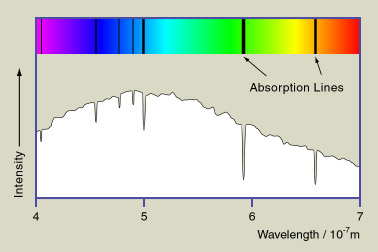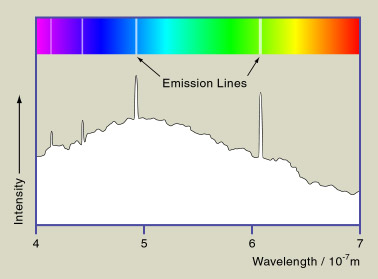Galileo was the first person who used a telescope to observe the sky.
We will see what a telescope is and the nature of light and electromagnetic
waves.
 Why Do We Need a Telescope?
Why Do We Need a Telescope?
Most objects in the sky are very dim. Telescope effectively
collects more light and converges it for our viewing. Thus, a telescope
with larger collecting area, which usually means larger main
mirror or lens, is more powerful. This is
the main reason why we prefer large telescopes. One of the largest
optical telescopes in the world is Keck Observatory. Astronomers are building
even larger ones: Giant Magellan Telescope, Thirty Meter Telescope and
The European Extremely Large Telescope.
Large telescopes also improve the resolution. We can
see more clearly even if the apparent size of an object is the same.
This is similar, but not equal to, seeing an object in or
out of focus.
There are three kinds of telescopes: the refracting telescopes
(refractors), the reflecting telescopes (reflectors) and
the catadioptric telescopes. In refractor, a lens is
used to bend light to a point, called the focus, for viewing.
In reflector, a mirror is used instead. Catadioptric
telescopes use both a lens, called correcting plate, and a mirror.
The following figure shows the three basic optical designs of telescopes.

Usually, apart from the main lens or mirror, there are more mirrors
to bring the focus to some convenient position, as shown in the
diagrams below.

Common misconceptions:
- People usually think that larger telescope will magnify the
object more. The magnification is the ratio of the apparent
sizes of the object. For example, if the angular size of the
object is one arc minute and through a telescope, its apparent
size becomes 30 arc minutes, then we say the magnification is 30.
The magnification of any telescope can be changed very easily
(by changing the eyepiece). Even for the largest telescopes, the
magnification is seldom over 500, usually between 100 - 200.
Thus, large telescopes do not magnify more, they only show brighter
and sharper images.
- "How far can you see using this telescope?" This is not
a well-defined question. If the object is bright enough, no matter
how far it is, we can see it. So, the correct question to ask is "How dim an object can you see using this telescope?"
The mount of a telescope is also very important. Apart from
providing a stable support, a mount should be able to
track the stars, that is, to compensate the rotation of the Earth.

So far, we have discussed telescopes for visible light.
There are telescopes for radio waves, infrared, X-rays and gamma
rays. They can be ground based or orbiting around the Earth. One
advantage of the space telescopes is that they will not be affected by
the atmosphere, e.g., weather or turbulence. The following
is a photo of the largest (in term of collecting area) radio wave
telescope, FAST
 Properties of Light
Properties of Light
We have mentioned radio waves, infrared, visible light, etc.
They are all different forms of the electromagnetic wave (EM wave).
Like the crests and troughs in water waves,
the oscillating electric and magnetic fields constitute
an EM wave. The speed of light c is the same for all
kinds of EM waves in vacuum (c=299792450m/s). The distance between
successive peaks of one kind of wave is called the wavelength
and the number of cycles that pass in one second is the
frequency. For EM wave in vacuum, their relation is
(wavelength) x (frequency) = c .
Each color of the rainbow has some definite frequency.

The wavelengths of visible light range from 400 nm to 700 nm.
Infrared and radio waves have longer wavelengths but lower
frequencies; ultraviolet and gamma ray have shorter
wavelengths and higher frequencies. The graph below shows the opacity of
our atmosphere to EM waves in different frequencies. We can see
that the Earth's atmosphere is opaque to, say, gamma rays and transparent
to the visible light. So, we have to put gamma ray
telescopes in space.

How can we create light? Just saying "Let there be light" will not
work very well. However, when we heat something up, it will
radiate EM waves.

To precisely describe the radiation, we specify the spectrum, which is a graph plotting the relative intensity at each wavelength of radiation. Usually, the spectrum does not tell us the luminosity, the total energy the object radiates out.For
a warm (or hot) and dense (non-gaseous substance in high pressure)
object (such as a star or a piece of metal), it will radiate light
(electromagnetic wave) in many frequencies, and its spectrum follows
what we call a black body radiation or black body spectrum.
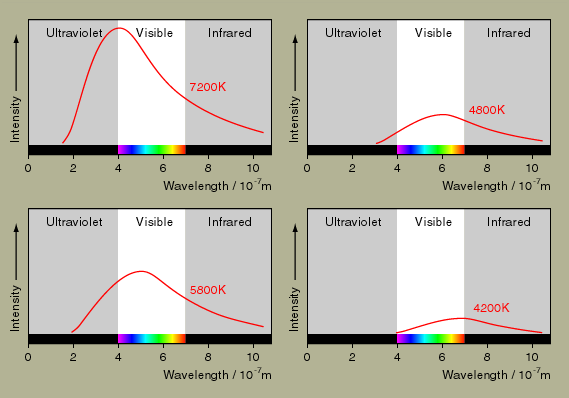
The
spectrum depends only on the surface temperature of the object. If the
temperature is low, the peak of the spectrum is at red region. For
higher temperature, the peak shifts towards the yellow, blue, finally
in the ultraviolet region. Different stars have different colors. In
general, if the peak of a spectrum is at the red light region, the star
will appear to be red. If the spectrum is flat, the star is white in
color.
Hotter objects also radiate more energy per unit area
than cooler objects. Therefore, the color of a star is mainly
determined by its surface temperature, but its luminosity is determined
both by its surface temperature and the surface area.
The spectrum in the above figure is continuous in frequency, but it is not
always the case. The spectrum from a star could have
absorption or emission lines.
Gas in low pressure and low density (e.g. the outer atmosphere of a
star) will alter the light that passes through it. It is because the
gas will absorb light at some particular wavelengths and re-radiate it
in random directions. Thus, after passing through the low pressure gas,
the spectrum of the original white light will have dark lines, called
absorption lines. In the other direction, we will see the emission
lines of the gas. Since different gas has different set of lines, we
can tell which kind of gas it is by analyzing the line spectrum.
 Doppler Effect
Doppler Effect
When the source of some wave is approaching you, the wave you
received will be in a higher frequency (shorter wavelength)
compared to the case when the source is stationary.
If the source is leaving you, you will see a lower-frequency wave (longer
wavelength). This is called the Doppler effect.
A clip of the effect is shown here.
In astronomy, we will call the EM wave blue-shifted or
red-shifted, because blue and red are respectively near
the frequency of high and low ends of the visible spectrum. If the
speed of the source is not large comparing with c, the ratio
of the change in wavelength is given by:
(observed wavelength - original wavelength) / original wavelength
= v / c
where v is the velocity of the source leaving you. By comparing the
absorption lines from a star to those obtained in a laboratory, we
can tell whether the star is moving away or towards us and
how fast the star is moving.
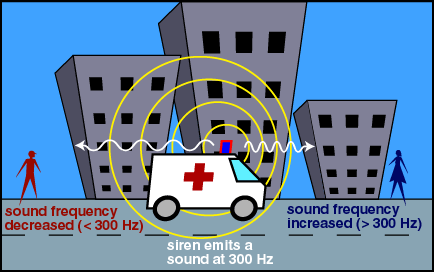
 Stellar Brightness
Stellar Brightness
We use the visual magnitude, also known as apparent magnitude,
to tell others how bright a
star is. It is a log scale in intensity. Thus, magnitude and intensity
both are scales for brightness of a star. Specifically, if star A
is 100 times brighter than star B, then the difference between the
magnitudes of A and B is defined to be 5.
mB - mA = 5 .
Note that a dimmer star has a larger magnitude number. We arbitrarily
choose one fixed star as the reference and define its magnitude as zero. Then,
the magnitude one stars are about 2.51 times dimmer for 2.515=100.
Similarly, a magnitude 5 star
is 100 times dimmer. The relation between the intensity, I and magnitude, m is
m = - 5/2 log 10 ( I / I 0) .
(What is I0?)
The following figure shows the magnitudes of some common objects.
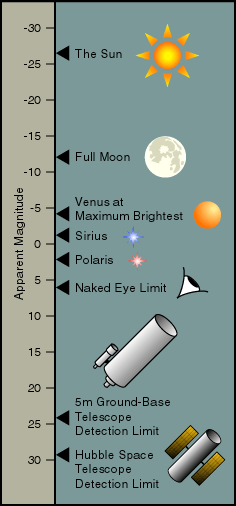





![]() Properties of Light
Properties of Light



